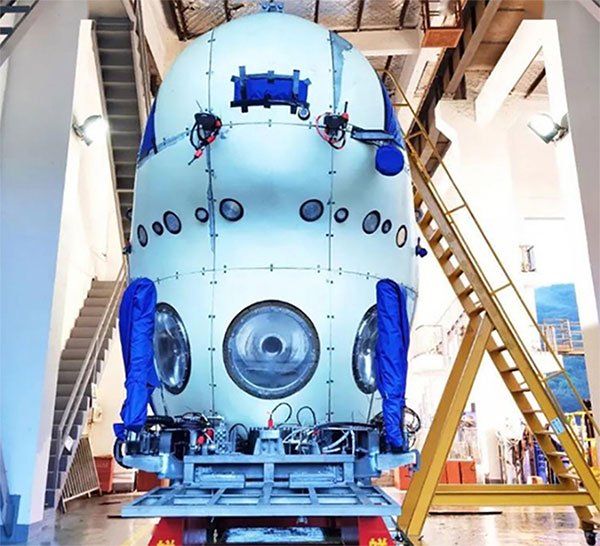China built a 10,000m deep diving expedition ship
The new manned submersible, built by China Shipbuilding Industry Group, will explore the deepest point of the world's oceans this year.
The device was assembled in March and is expected to have its first test trip next month. The ship is capable of diving 10,000 meters deep, with the goal of bringing scientists to the Challenger abyss in the Pacific Ocean, the southern part of the Mariana Trench.

China's new deep-sea exploration ship is about to be put to the test. (Photo: CGTN).
According to Design Director Ye Cong, to dive to the deepest point of the Earth, the ship will be subjected to a pressure of up to 1,100 atmospheres, equivalent to 10,000 tons of force per square meter of area. This poses major challenges in the design and construction materials of submersibles.
The researchers said they removed the original petal design to build a spherical shell, which reduced the number of welds and significantly improved stability. The vessel is also added with floating materials to provide the necessary support during the dive.
"This project will demonstrate China's technological progress, as well as its ability to detect and research the ocean," Ye said.
The new submarine is not China's first manned deep-sea exploration device. In June 2012, the country's Jiaolong submarine set a world record when reaching a depth of 7,062 m below sea level. The second ship, the Shenhai Yongshi, also built by China Shipbuilding Industry Group, is capable of diving 4,500 meters deep.
- The kit supports deep diving
- Antarctic Project-100: Russian divers reach the world record
- China spent $ 22 million to study the East Sea
- Dive into the South Pole Sea 97m, the world record
- Chinese diving ship caught the
- New details about the Arctic seabed expedition
- The way the submarine sends a signal for help in distress
- Diving aids like jets
- Not diving can still explore the ocean
- China's Hang Nga 2 ship orbit L2
- The monsters in the deep sea 4.800m in Australia
- The explorer ship re-emerged after 86 years buried under the Arctic ice
 The US company is about to build a supersonic passenger plane of 6,000km / h
The US company is about to build a supersonic passenger plane of 6,000km / h Japan develops avatar robot as in fiction film
Japan develops avatar robot as in fiction film Australia tested the world's first mango picking robot
Australia tested the world's first mango picking robot America develops technology to separate water from animal waste
America develops technology to separate water from animal waste US experts warn about Covid-26 and Covid-32
US experts warn about Covid-26 and Covid-32  Good at 'copying technology', Vietnam's neighbor is accelerating: About to surpass the US?
Good at 'copying technology', Vietnam's neighbor is accelerating: About to surpass the US?  China releases first image taken by wide-field telescope
China releases first image taken by wide-field telescope  China launches unprecedented technological 'monster', solving mega-project that both the US and Japan are stumped by
China launches unprecedented technological 'monster', solving mega-project that both the US and Japan are stumped by  China successfully tests inflatable spacecraft capsule
China successfully tests inflatable spacecraft capsule  China produces the world's most powerful hydraulic cylinder
China produces the world's most powerful hydraulic cylinder 